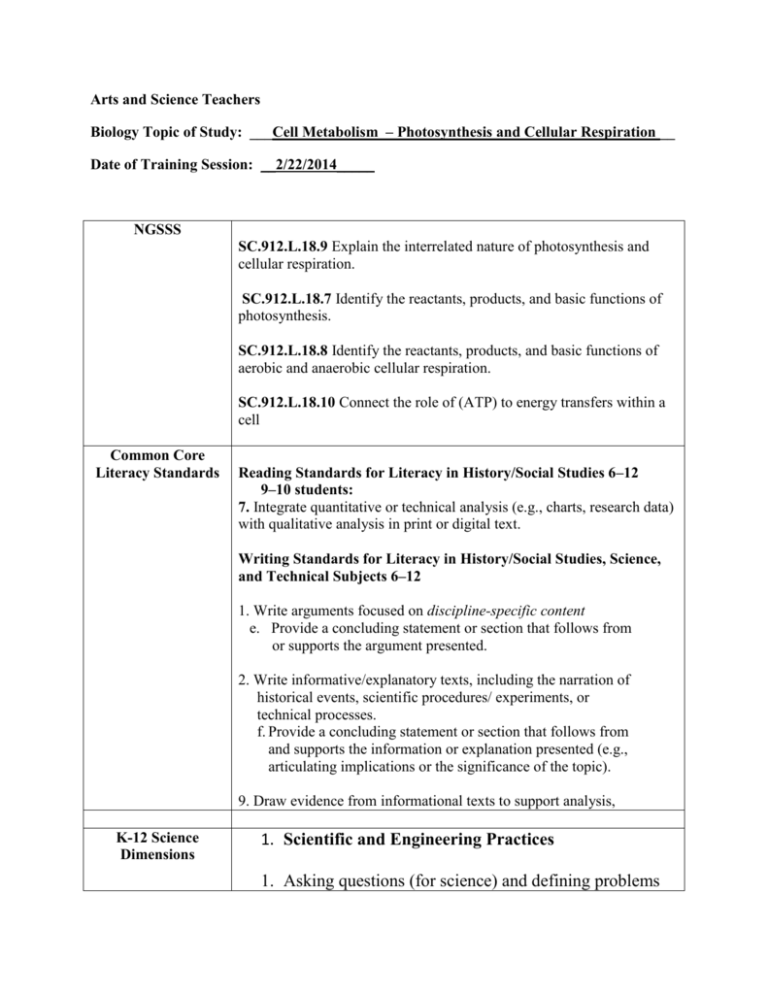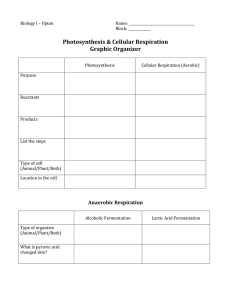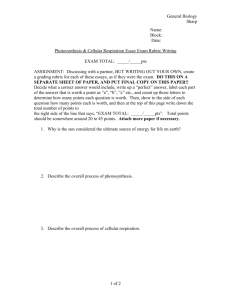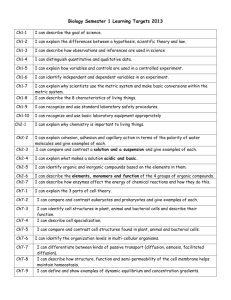Arts and Science Teachers
advertisement

Arts and Science Teachers Biology Topic of Study: ___Cell Metabolism – Photosynthesis and Cellular Respiration __ Date of Training Session: __2/22/2014_____ NGSSS SC.912.L.18.9 Explain the interrelated nature of photosynthesis and cellular respiration. SC.912.L.18.7 Identify the reactants, products, and basic functions of photosynthesis. SC.912.L.18.8 Identify the reactants, products, and basic functions of aerobic and anaerobic cellular respiration. SC.912.L.18.10 Connect the role of (ATP) to energy transfers within a cell Common Core Literacy Standards Reading Standards for Literacy in History/Social Studies 6–12 9–10 students: 7. Integrate quantitative or technical analysis (e.g., charts, research data) with qualitative analysis in print or digital text. Writing Standards for Literacy in History/Social Studies, Science, and Technical Subjects 6–12 Grades 1. Write arguments focused on discipline-specific content e. Provide a concluding statement or section that follows from or supports the argument presented. 2. Write informative/explanatory texts, including the narration of historical events, scientific procedures/ experiments, or technical processes. f. Provide a concluding statement or section that follows from and supports the information or explanation presented (e.g., articulating implications or the significance of the topic). 9. Draw evidence from informational texts to support analysis, K-12 Science Dimensions 1. Scientific and Engineering Practices 1. Asking questions (for science) and defining problems 2. 3. 4. 5. (for engineering) Developing and using models Planning and carrying out investigations Analyzing and interpreting data Using mathematics and computational thinking 2. Crosscutting Concepts 1. Patterns 2. Cause and effect: Mechanism and explanation 3. Scale, proportion, and quantity 4. Systems and system models 5. Energy and matter: Flows, cycles, and conservation Life Sciences From molecules to organisms: Structures and processes How organisms obtain and use energy, the energy molecule, aerobic versus anaerobic respiration, data analysis FEAPs 1. Instructional Design and Lesson Planning. Applying concepts from human development and learning theories. 2. The Learning Environment. To maintain a student-centered learning environment that is safe, organized, equitable, flexible, inclusive, and collaborative. 3. Instructional Delivery and Facilitation. The effective educator consistently utilizes a deep and comprehensive knowledge of the subject. 4. Assessment. 5. Continuous Professional Improvement. 6. Professional Responsibility and Ethical Conduct. (See FEAPs attachment for details)











